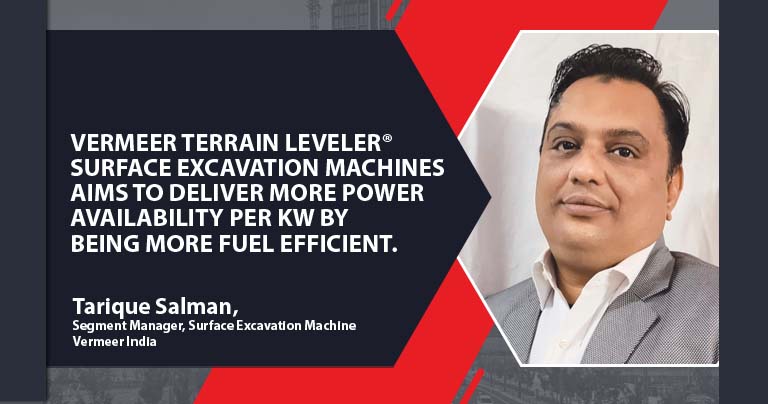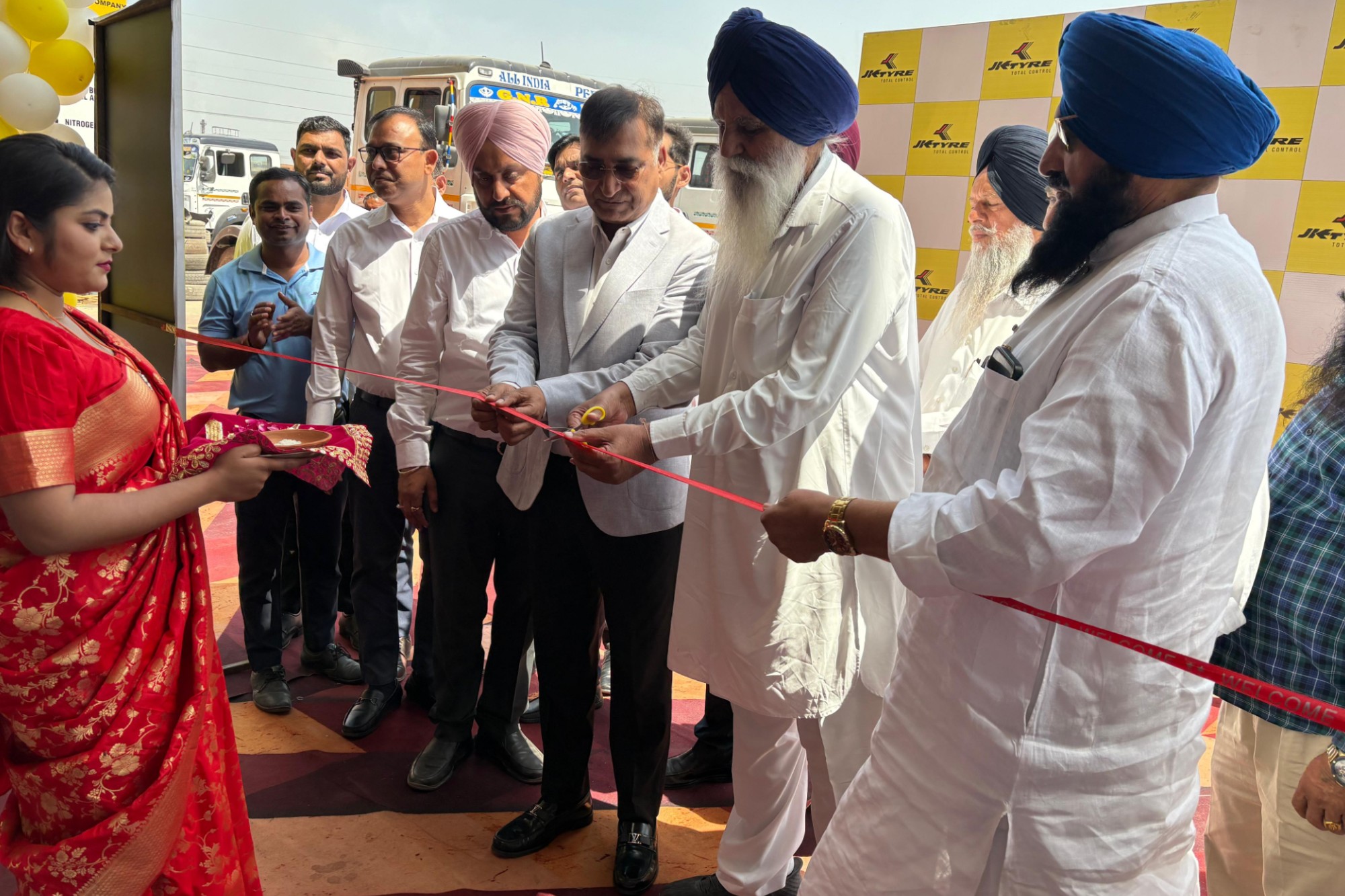The need for opencast mining equipment is expected to rise in future
By Edit Team | January 10, 2022 12:14 pm SHARE

Tarique Salman, Segment Manager, Surface Excavation Machine, Vermeer India, in an interview with B2B Magazine.
Equipment and technology trends in surface mining
Mining, one of the oldest industries on the planet, is at an inflection point. All parts of the industry, from exploration, production, processing, and transportation, are undergoing a transformation. The mining sector needs to foster innovation to remain competitive.
This has created a demand for technologies such as industrial automation and control systems, simulator training, equipment control and guidance, advanced mine surveying technologies, underground mining and surface drilling technologies, and machine guidance and control systems, which are compatible with enterprise resource planning software solutions.
A trend in mining technology has also been towards addressing the concerns of climate change and, hence, reducing carbon footprints. The usage of more energy-efficient equipment and a reduction in fuel consumption are attempts in the right direction towards achieving reduced carbon footprints. Vermeer Terrain Leveler® Surface Excavation Machines are designed to deliver more power availability per kW, thus being more fuel efficient.
The Vermeer T1255III direct drive terrain leveler SEM features a fully hydrostatic motor mounted to the side of the cutting head, providing direct drive power to the cutting drum. The direct drive drum design delivers more horsepower to the cutting drum, resulting in enhanced efficiency when working in hard rock conditions.
Mining, one of the oldest industries on the planet, is at an inflection point. All parts of the industry, from exploration, production, processing, and transportation, are undergoing a transformation. The mining sector needs to foster innovation to remain competitive. This has created a demand for technologies such as industrial automation and control systems, simulator-training, equipment control and guidance, advanced mine surveying technologies, underground mining and surface drilling technologies, and machine guidance and control systems, which are compatible with enterprise resource planning software solutions. A trend in mining technology has also been towards addressing the concerns of climate change and, hence, reducing carbon footprints. The usage of more energy efficient equipment and a reduction in fuel consumption are attempts in the right direction towards achieving reduced carbon footprints. Vermeer Terrain Leveler® Surface Excavation Machines are designed to deliver more power availability per kW, thus being more fuel efficient. The Vermeer T1255III direct drive terrain leveler SEM features a fully hydrostatic motor mounted to the side of the cutting head, providing direct drive power to the cutting drum. The direct drive drum design delivers more horsepower to the cutting drum, resulting in enhanced efficiency when working in hard rock conditions.
Dust Suppression System: On many mine sites, dust is a challenge due to urban encroachment and air quality concerns. An optional dust suppression system on the Vermeer Terrain Leveler SEM features an enclosed cutting head with two large vacuums pulling dust from the enclosed cutting head into bag houses. The collected dust is dropped beneath the machine, helping to reduce the amount of dust entering the air. This also diminishes the need to source water to control dust during the mining process.
Robotics & Automation: The application of robotic technology, although very limited in current mining operations around the world, has far-reaching potential for the mining industry. Robotic devices powered by artificial intelligence can perform a range of tasks, including drilling, blasting, loading, hauling, bolting mine roofs, ore sampling, and rescuing trapped miners. Autonomous Load Haul Dump (LHD) vehicles using robotic technology have been developed and deployed at many mines.
Drones: The mining industry has recently started to make use of drones, or unmanned aerial systems (UAS). Drones, when set to perform operational tasks, improve the industry by providing the following services:
- Site mapping
- Safety and surveillance in hazardous areas
- Equipment and Workforce Monitoring
- Inventory stockpile measurement
- Infrastructure upkeep and inspection
The Internet of Things (IoT): an emerging network technology based on the convergence of wireless technologies, microelectromechanical systems (MEMS) and the Internet, can potentially transform the mining industry by creating new ways of maintaining mine safety and productivity.
The technology involves connecting machines, fleets, and people with unique identifiers based on radio frequency identification device (RFID) and sensor technologies, allowing them to automatically transfer and receive data over a network without requiring human-to-human or human-to-computer interaction.
Safety Features: The Vermeer Terrain Leveler SEM features an operator presence system that disengages the ground drive and cutting attachment if the operator leaves the seat. The machines are available with a rollover protective module (ROPM) and a falling object protective structure (FOPS) for working near a high pit wall. The machine’s low center of gravity helps maintain machine stability. In addition, it has a pressurised cab with a filtered air system to provide an increased level of operator comfort.
GPS technologies and autonomous control: Global Positioning Satellite (GPS) positioning and navigation systems have recently been developed and implemented by some mining companies on blasthole drills and electric cable shovels in their open-pit mines. These GPS systems produce accurate, three-dimensional visualizations of the location of the drill bit or the shovel tracks in real-time via a Moving Map Display (MMD) on a screen. This allows the operator to accurately navigate the drill from blasthole to blasthole, maintain a desired shovel grade, or face position from a remote location.
The T1255III Terrain Leveler SEM also features optional GPS technology that can also be used to create a mine-by-line plan. A mine plan can be uploaded to the GPS system and the machine will automatically cut to the plan.
Machine steering is controlled by GPS technology, helping remove human error by cutting head overlap and maximising the efficiency of the machine. The GPS system provides an overlap cut of only 6 inches (15.2 cm). A patented tilt cutting head tied to GPS technology allows the operator to control the cutting head depth and pitch.
Monitoring and control solutions to enhance performance efficiency
The mining industry is complex and requires a diverse and sophisticated range of machinery and equipment. Mine capital expenditures are high, requiring close attention to the utilization and productivity of mine equipment in order to maximize capital efficiency. Whether it’s monitoring brake heat temperatures or monitoring engine data to ensure equipment is running at peak performance, everything that affects the operations and cost of maintaining equipment needs to be considered.
Most mining operations have management plans and software systems for managing production, maintaining and servicing equipment, and providing safe mine operations. However, there is an evolution happening in industrial environments such as mining. Technology innovation is bringing things such as machine learning, analytics, artificial intelligence, and the Industrial Internet of Things (IIOT) to these industries with the promise of higher production, lower operating costs, improved performance, optimised operations, and more. In order to take advantage of this technological evolution, you need access to data. Data generated by equipment can provide useful business intelligence.
The SmartTEC Performance Software on Terrain Leveler® assists operators with adjustments to machine controls to improve efficiency and tracks the productivity of the machine. Performance history is recorded, including individual operator history, for analysis by the machine owner or fleet manager. SmartTEC screens also offer a cleaner display, showing only what the operator needs to improve control and production.
The drivers of enhancing productivity and operational safety shift towards integrating innovation in mining are many and well known. Labor costs are high for many mining companies, with large wage premiums in the sector due to skills shortages and an ageing workforce. Automated technologies allow companies to remove staff from dangerous working conditions. Efficiency and productivity gains can be substantial, particularly for those companies operating in remote areas with high fuel costs. The costs of such technology are falling, sometimes rapidly, giving companies further opportunities to reduce and manage their operating costs in the face of volatile commodity markets. As these technologies are increasingly proven to be commercially viable, the risks associated with their adoption diminish, and companies themselves face pressure to compete with technology leaders.
Available preventive and predictive maintenance solutions
The advanced digital service for proactive asset management integrates and analyses condition data from all types of equipment used in mining to reduce maintenance costs and increase operational efficiency. By pulling together previously disparate condition data from various equipment, to collectively analyse and compare all the data, the system is able to provide forewarning of a potential fault (i.e., lubrication failure) with a proposed solution, all with enough time to address it before production is affected. A critical analysis of each asset, equipment, or component takes into account failure modes, available control system data, as well as information from pre-installed expert condition monitoring systems and datasheets.
Vermeer Telematics is an online tool for tracking machine productivity and jobsite management on telematics-enabled equipment. Fleet or operations managers can access Telematics by using a smartphone, tablet, or computer to view real-time information about the GPS location, productivity (including idle times and fuel consumption), and maintenance needs of their Vermeer equipment.
Telematics sends alerts when a machine is operating outside of its expected GPS location and notifications when planned maintenance or service needs to be performed. It captures planned maintenance schedules and completed services to help maximize machine efficiency and productivity, as well as help extend the life of the equipment.
Forthcoming digital features in mining equipment
Automation and robotics are both parts of an overall approach to decoupling humans from technical machinery. “Robotics” deals with the development and usage of robots, whereas “automation” defines the operation of existing machines and unattended processes without human control.
In particular, surface mines use automated trucks, where constant and long-lasting haulage roads and simple implementation of communication infrastructures such as GPS or LTE allow the successful implementation of automation systems.
Using technology from Trimble, a global leader in GPS technology, the Vermeer T1255 direct-drive Terrain Leveler® surface excavation machine (SEM) now offers GPS steering as an option. When equipped with this optional feature, the machine steering is controlled by an onboard GPS device that can detect deviations from the designed line to provide greater accuracy on each cutting pass. The optional system provides a cutting overlap of 6 inches (15.2 cm), helping to enhance productivity with each pass.
GPS technology can be used to create a mine-by-line plan. A company starts by conducting a GPS survey of the jobsite; that information is given to a designer who creates a plan, and then that plan is uploaded to the GPS system on the Terrain Leveler SEM. The operator selects that plan, and the GPS system steers the machine along the proper line provided by the survey.
Moreover, the industry is witnessing the large-scale adoption of different clusters of technologies, such as robotics and automation, smart sensors, and 3D printing, to enhance operational efficiency.
Growth projections in the post-Covid scenario
The COVID-19 pandemic had an immediate impact on the economy, and that impact goes across all industries, including mining. Significant price drops were observed across major commodities, while in some cases, prices remained passive.
The government of India clearly stated during the Union Budget 2021 its focus on investment in infrastructure projects. There are large projects under construction in roads and highways, railways, irrigation, etc., which will increase demand for steel, cement, and other construction materials. This, in turn, will put pressure on producers to produce more from non-coal mineral mines. There is significant scope for new mining capacities in iron ore, bauxite, and limestone, given strong growth expectations in residential and commercial building infrastructure.
In India, opencast mining is more popular compared to underground mining. Hence, the demand for mining equipment for opencast mines would see an increase in demand for technologically advanced mining equipment offering unique features achieving sustainability.
Cookie Consent
We use cookies to personalize your experience. By continuing to visit this website you agree to our Terms & Conditions, Privacy Policy and Cookie Policy.























































